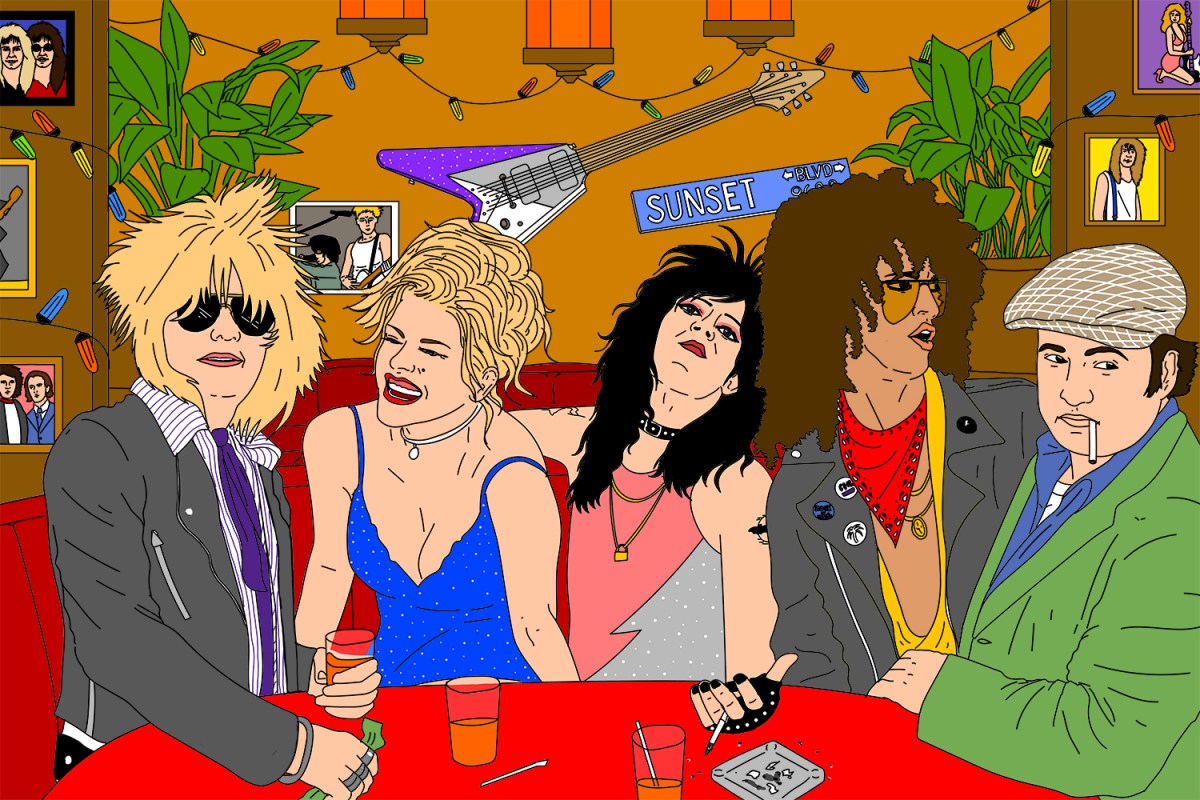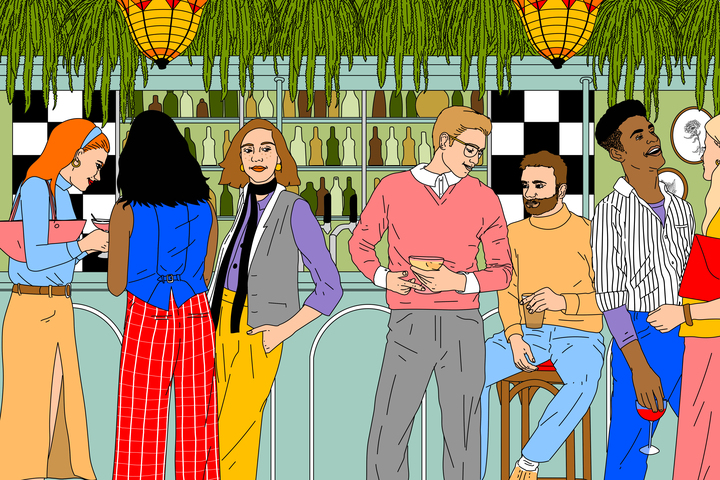Welcome back to Behind Bars, a look back at the great drinking scenes of yesteryear. Today, Aaron Goldfarb visits Los Angeles in the 1980s to recount the nascent glam-rock scene that was then cropping up along the Sunset Strip.
In the early months of 1981, Vince Neil, Tommy Lee and Nikki Sixx moved into a filthy, white apartment complex on 1124 North Clark Street. The two-bedroom was financed by their manager. In apartment #205, they wrote songs for their then-unknown band Mötley Crue, but they mostly drank and did drugs with an always-crowded house of people. Groupies would arrive in shifts, like hockey lines subbing in and out. Every night, the trio would leave their hovel and walk down the sloped block to what was becoming one of the greatest bar scenes in American history.
“We’d get drunk, do crazy amounts of cocaine and walk the circuit in stiletto heels, stumbling all over the place,” claimed Neil in The Dirt: Confessions of the World’s Most Notorious Rock Band. “The Sunset Strip was a cesspool of depravity.”
Running through the city of West Hollywood between Los Angeles and Beverly Hills, this 1.5-mile stretch of Sunset Boulevard had always been a fairly wild area, due it being unincorporated (until 1984) and not under the jurisdiction of the Los Angeles Police Department. Loosely overseen by the County Sheriff’s Department, no one really monitored what was going on — thus, it became a hotbed of liquor, drugs, nightlife and shenanigans.
In the 1920s the Sunset Strip had hosted speakeasies and underground casinos; the 1930s through ’50s would see glamorous restaurants and nightclubs spring up to be frequented by movie-industry hot shots; by the 1960s, hippies and the counterculture were slowly working their way there as clubs like Whisky a Go Go (1964), Pandora’s Box (1966) and the Roxy Theater (1973) sprung up and bands like The Doors dominated the scene; the 1970s saw more new wave and punk acts like The Stooges and New York Dolls.
It was the 1980s, however, when the so-called “Sunset Strip” might have reached its apex as, according to Rolling Stone, “big-haired dudes and the girls who loved them turned the boulevard into their own personal playground.”
The big-haired dudes of Mötley Crue would actually make their debut right off the Strip, as an opening act at Starwood on Santa Monica Boulevard on April 24th of 1981. Even if that early set included a cover of The Beatles’ catchy pop hit Paperback Writer, the raucous rockers quickly started setting a template for how to behave on the Sunset Strip. Especially as their shows moved to the Whisky a Go Go, just about 200 feet from their crash pad.
“Did I tell you about the time I tied a girl up in the Whisky bathroom with Mick’s guitar cable, and then went to get a bump of blow from Tommy?” Sixx told LA Weekly in 2011. “I forgot she was in there! I think Vince found her and everything was [fine]. Ah, to be in Mötley Crüe in 1981 in Los Angeles.”
Ah, to be anyone who visited the Sunset Strip in the early 1980s when, on any given night, the bars and clubs might feature sets from perhaps 75 to 100 emerging and already-made-it bands like Black Flag, the Dead Kennedys, The Misfits, Motörhead and even Metallica, who first opened for Saxon at the Whisky a Go Go in August of 1982.
“I think of all the late nights and early mornings, probably the craziest year of my life in L.A.,” Lars Ulrich told Mick Wall for his book Enter Night: A Biography of Metallica. “Living everything that you can imagine when you’re twenty-six years old in L.A. and your dick is fucking six feet long.”
The favored haunt of many rockers was The Rainbow Bar & Grill, just across the street from the Whisky, at the corner of Crescent Heights Boulevard. (“[T]he reason is simple: the clam chowder,” Sixx once told LA Weekly.) It opened in 1972 by hosting a party for Elton John, but by the 1980s had become the after-hours hangout for various hair bands and their hangers-on.
“The place was set up like a circle, with the coolest rockers and richest deviants sitting at the center tables,” explained Lee to Curbed in 2019. “Guys had to be twenty-one to come into the club, but girls could be eighteen. The guys would sit at their regular spots and the girls would walk around the ring until they were called over to someone’s empty chair.”
After everybody was kicked out of the Rainbow, they’d spew into the parking lot to score drugs and girls, before heading back to 1124 North Clark. More and more bands started joining the party, but the Strip also had bars like The Comedy Store, where you might be able to see Robin Williams or Sam Kinison doing stand-up on any given night — it was wild even there, where “half-naked women draped over fat, out-of-shape funny men, booze and drugs flowing freely,” as Corey Feldman wrote in his memoir, Coreyography. There were also gentlemen’s clubs like Seventh Veil and The Body Shop, both of which would eventually be name-checked in Mötley Crue’s Girls, Girls, Girls while providing some of the girls, girls, girls for the music video.
Further up the block, at Santa Monica Boulevard just east of Doheny Drive, was the Troubadour. Lenny Bruce had been arrested there on obscenity charges in 1962, and it was the place where Steve Martin was discovered. By the 1980s, however, it was all hair bands all the time. A Slash-less Guns ‘n’ Roses would play their first ever show there (where they were discovered by a David Geffen A&R rep at the club). Poison, too, would get their start at the Troubadour.
“When we finally pulled onto the Strip it was, ‘Holy shit!’” Bret Michaels recalled to Rolling Stone. He and his bandmates had driven in from Mechanicsburg, Pennsylvania, in March of 1983. By then the billboards lining the Strip were going for $4,000-$6,000 a month in rent; pure vanity for the now-famous musicians who had actually made it at the clubs below. “We’re driving past the Rainbow, Gazzarri’s, the Roxy, the Whisky, and there’s gotta be, like, 100,000 people walking around. And they all look like they’re in a band. For a bunch of small-town guys, that’s a lot to take in.”
A block away from the Rainbow was Gazzarri’s. A sensation when it opened, the club was well past its heyday by the mid-1970s. Then Van Halen became its house band from 1974 to 1977 and put it back on the map. That ushered in a 1980s scene with bands like Quiet Riot, Warrant and Stryper, many of whom would eventually be honored with giant hand-painted murals on the outside wall of the club.
From the front steps of Gazzarri’s, 300 feet of Strip sidewalk led to a parking lot between the Rainbow and the Roxy Theatre. Aspiring bands would congregate there, passing out handmade show flyers, hustling for gigs, buying drugs, and getting into amorous hijinks.
“I saw so many people fucking on the lawns behind Gazzarri’s that I actually got bored of watching and started to throw empty beer cans at them,” Ratt frontman Stephen Pearcy wrote in his autobiography Sex, Drugs, Ratt & Roll: My Life in Rock.
It wasn’t all inconsequential fun, however. On March 4, 1982, Harry Dean Stanton and Robert De Niro coaxed a disheveled John Belushi out for a night of bar-hopping on the Strip, starting at On the Rox, the lounge above the Roxy. At the Rainbow he ordered not clam chowder, but lentil soup, before returning to bungalow No. 3 at the Chateau Marmont and overdosing on a speedball. As Shawn Levy noted in his book about the luxury hotel, The Castle on Sunset: “It stood slightly apart from the commotion around it — compact, old-world, elegant, just off to the side of the circus, much as it sat just off Sunset Boulevard itself. After Belushi, that changed.”
By 1984 the Strip was finally getting some legitimacy, especially when, according to Visit West Hollywood, “a coalition of gay men, Russian Jews and the elderly” successfully held a vote to incorporate the area as the new City of West Hollywood. Now under the watch of a city council run predominantly by an often persecuted, openly gay majority, the area was bound to stay a bit wild, but it would never be quite the same.
“The era of glam metal would be the last gasp of lawlessness on the Sunset Strip,” writes Hadley Meares on Curbed. Every band, fan and groupie started looking the same, and a few other things were about to spell its end. The arrival of grunge was one, with Nirvana rocking The Roxy as early as August of 1991. The growing corporatization was another, as high-priced hotels and condos sprung up, as well as theme-like chain bars like The House of Blues, “the toxic fruit of an alliance between Hard Rock Café co-founder Isaac Tigrett and the insufferably unfunny Dan Aykroyd,” according to LA Weekly. And if neither Belushi’s death nor Nikki Sixx’s near-brush with it in Slash’s room in 1987 didn’t slow down the party, River Phoenix’s 1993 overdose at the just-opened Viper Room would.
By 2005, a sanitized stage production called Rock of Ages (followed by a 2012 film of the same name, starring Tom Cruise as “Stacee Jaxx”) — with its storyline centered around the Sunset Strip in 1987 — was all that was left to honor the era. The Strip has now gone “From Louche to Luxury” as the Wall Street Journal write in 2018. “To make way for the new vision of Sunset, some of the most iconic symbols of its past are being demolished.”
Gazzarri’s closed in 1993, but the Whisky, Roxy, Rainbow and Troubadour still stand, though you’ll rarely see a major act appear there these days. Even the strip clubs are apparently no fun anymore; LAist by 2008 was calling Seventh Veil “The Least Exciting Strip Club in Hollywood,” with Jessica P. Ogilvie writing “The club had seemingly remained firmly, unapologetically and possibly even aggressively in the 80’s.”
Today, the Strip that was once described as a “cheerfully depraved Aqua Net playground” instead has over one million square feet of luxury hotels like 1 West Hollywood and condos like AKA West Hollywood, where single-family homes go for around $2.5 million. It has private clubs like Soho House and the Gwyneth Paltrow-backed The Arts Club (which replaced a Hustler Store they bought for $18.3 million); there’s an Armani store, a Fred Segal and a Warby Parker; you can even get an “Originally from ‘’Dorchestah’” burger at Wahlburger’s.
“What the fuck happened?” wrote MÖRAT in a 2015 article “Farewell to the Sunset Strip” on Metal Hammer. He notes that the biggest band playing there these days is Steel Panther.
“Doubtless you’ll see some great bands from time to time, but rarely any truly great shows, rarely a band at their peak, playing the kind of shows that keep you buzzing for weeks afterwards.”
Every Thursday, our resident experts see to it that you’re up to date on the latest from the world of drinks. Trend reports, bottle reviews, cocktail recipes and more. Sign up for THE SPILL now.






















